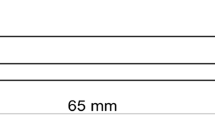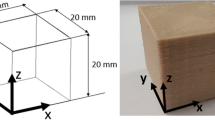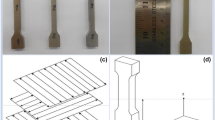Abstract
FDM parts are susceptible to low-dimensional accuracy due to the involvement of numerous process parameters. It is highly essential to identify the significant influencing parameter and optimal parameter setting for reducing dimensional inaccuracies. The main objective of this paper is to investigate the influence of six FDM parameters such as layer thickness, extrusion temperature, bed temperature, print speed, raster angle and part orientation over the dimensional deviations in a cuboid sample with hole at centre through L18 mixed fractional factorial design. The prepared specimens are evaluated for geometric deviations and the errors are analyzed using SWARA-CoCoSo and machine learning algorithms. The optimal parameter combination for reduced dimensional error is predicted as A2B3C3D2E3F3 (0.14 mm layer thickness, 235 °C print temperature, 90 °C bed temperature, 40 mm/s print speed, 45° raster angle and upright positioned printing). Layer thickness is found to be highly significant than any other process parameter with maximum contribution of 64.49% and subsequently followed by print speed with 13.55%.The final appraisal score of SWARA-CoCoSo technique has been trained and tested using machine learning algorithms. Adaboost algorithm outperformed all other regression algorithms with maximum R2 value of 0.999 and Decision tree algorithm ranked top in case of classification algorithms with maximum accuracy of 94.4%.The predictions of SWARA-CoCoSo and machine learning algorithms are in good agreement in identifying the optimal parameter combination and highly influencing parameter. Surface morphology of samples carried out through FESEM ensures the presence of voids, pores and irregular layers deposited at higher layer thickness values.




















Similar content being viewed by others
Abbreviations
- FDM:
-
Fused deposition modeling
- SWARA:
-
Step-wise weight assessment ratio analysis
- CoCoSo:
-
Combined compromise solution
- ABS:
-
Acronitrile butadiene styrene
- PLA:
-
Poly lactic acid
- PET-G:
-
Polyethylene terephthalate glycol-enhanced
- HIPS:
-
High impact polystyrene
- PC:
-
Polycarbonate
- ANOVA:
-
Analysis of variance
References
N.W.Y. Omar, N.A. Shuaib, M.H.J.A. Hadi, and A.I. Azmi, Mechanical Properties of Carbon and Glass Fibre Reinforced Composites Produced by Additive Manufacturing: A Short Review, IOP Conf. Ser. Mater. Sci. Eng., 2019 https://doi.org/10.1088/1757-899X/670/1/012020
X. Tian et al., 3D Printing of Continuous Fiber Reinforced Polymer Composites: Development, Application, and Prospective, Chinese, J. Mech. Eng. Addit. Manuf. Front., 2022, 1(1), p 100016. https://doi.org/10.1016/j.cjmeam.2022.100016
J.S. Chohan et al., Optimization of FDM Printing Process Parameters on Surface Finish, Thickness, and Outer Dimension with ABS Polymer Specimens Using Taguchi Orthogonal Array and Genetic Algorithms, Math. Probl. Eng., 2022 https://doi.org/10.1155/2022/2698845
E. Vahabli and S. Rahmati, Application of an RBF Neural Network for FDM Parts’ Surface Roughness Prediction for Enhancing Surface Quality, Int. J. Precis. Eng. Manuf., 2016, 17(12), p 1589–1603. https://doi.org/10.1007/s12541-016-0185-7
E. Molero, J.J. Fernández, O. Rodríguez-Alabanda, G. Guerrero-Vaca, and P.E. Romero, Use of Data Mining Techniques for the Prediction of Surface Roughness of Printed Parts in Polylactic Acid (PLA) by Fused Deposition Modeling (FDM): A Practical Application in Frame Glasses Manufacturing, Polymers (Basel), 2020 https://doi.org/10.3390/POLYM12040840
K. Muhamedagic et al., Effect of Process Parameters on Tensile Strength of FDM Printed Carbon Fiber Reinforced Polyamide Parts, Appl. Sci., 2022 https://doi.org/10.3390/app12126028
J. Nagendra and M.S.G. Prasad, FDM Process Parameter Optimization by Taguchi Technique for Augmenting the Mechanical Properties of Nylon-Aramid Composite Used as Filament Material, J. Inst. Eng. Ser. C, 2020, 101(2), p 313–322. https://doi.org/10.1007/s40032-019-00538-6
M.S. Alsoufi and A.E. Elsayed, Surface Roughness Quality and Dimensional Accuracy—A Comprehensive Analysis of 100% Infill Printed Parts Fabricated by a Personal/Desktop Cost-Effective FDM 3D Printer, J. Lipid Res., 2018 https://doi.org/10.4236/msa.2018.91002
M.S. Alsoufi and A.E. Elsayed, Quantitative Analysis of 0% Infill Density Surface Profile of Printed Part Fabricated by Personal FDM 3D Printer, Int. J. Eng. Technol., 2018, 7(1), p 44–52. https://doi.org/10.14419/ijet.v7i1.8345
C.C. Wang, T.W. Lin, and S.S. Hu, Optimizing the Rapid Prototy** Process by Integrating the Taguchi Method with the Gray Relational Analysis, Rapid Prototyp. J., 2007, 13(5), p 304–315. https://doi.org/10.1108/13552540710824814
M. Ramesh and K. Panneerselvam, Mechanical Investigation and Optimization of Parameter Selection for Nylon Material Processed by FDM, Mater. Today Proc., 2019, 46, p 9303–9307. https://doi.org/10.1016/j.matpr.2020.02.697
N. Decker and A. Yee, A Simplified Benchmarking Model for the Assessment of Dimensional Accuracy in FDM Processes, Int. J. Rapid Manuf., 2015, 5(2), p 145–154.
K. Mohan, P. Shubham, D. Bhatia, P. Sharma, and H. Vaid, Analyzing the Impact of Print Parameters on Dimensional Variation of ABS Specimens Printed Using Fused Deposition Modelling (FM ), Sens. Int., 2022, 3(21), p 100149. https://doi.org/10.1016/j.sintl.2021.100149
S.L. Messimer, T.R. Pereira, A.E. Patterson, and M. Lubna, Full-Density Fused Deposition Modeling Dimensional Error as a Function of Raster Angle and Build Orientation: Large Dataset for Eleven Materials, J. Manuf. Mater. Process., 2019 https://doi.org/10.3390/jmmp3010006
G.W. Melenka, J.S. Schofield, M.R. Dawson, J.P. Carey, M.R. Dawson, and J.P. Carey, Evaluation of Dimensional Accuracy and Material Properties of the MakerBot 3D Desktop Printer, IOP Conf. Ser. Mater. Sci. Eng., 2015 https://doi.org/10.1108/RPJ-09-2013-0093
M. Pant et al. Research on shape and dimensional accuracy of FDM produced parts research on shape and dimensional accuracy of FDM produced parts, in IOP Conference Series: Materials Science and Engineering (IOP Publishing, 2019). https://doi.org/10.1088/1757-899X/501/1/012030
B. Zharylkassyn, A. Perveen, and D. Talamona, Materials Today: Proceedings Effect of Process Parameters and Materials on the Dimensional Accuracy of FDM Parts, Mater. Today Proc., 2021, 44, p 1307–1311.
J. Singh and C. Rupinder, Enhancing Dimensional Accuracy of FDM Based Biomedical Implant Replicas by Statistically Controlled Vapor Smoothing Process, Prog. Addit. Manuf., 2016 https://doi.org/10.1007/s40964-016-0009-4
T.R.D.R.V. Nancharaiah, D.R. Raju, and V.R. Raju, An Experimental Investigation on Surface Quality and Dimensional Accuracy of FDM Components, Int. J. Emerg. Technol., 2010, 1(2), p 106–111.
A. Khalil, F.E. Ahmed, and N. Hilal, The Emerging role of 3D Printing in Water Desalination, Sci. Total Environ., 2021, 790, p 148238. https://doi.org/10.1016/j.scitotenv.2021.148238
L.D. Ti**g, J.R.C. Dizon, I. Ibrahim, A.R.N. Nisay, H.K. Shon, and R.C. Advincula, 3D printing for membrane separation, desalination and water treatment, Appl. Mater. Today, 2020, 18, p 1–39. https://doi.org/10.1016/j.apmt.2019.100486
P.P. Das and S. Chakraborty, SWARA-CoCoSo Method-Based Parametric Optimization of Green dry Milling Processes, J. Eng. Appl. Sci., 2022, 69(1), p 1–21. https://doi.org/10.1186/s44147-022-00087-3
P.P. Dwivedi and D.K. Sharma, Application of Shannon Entropy and CoCoSo Methods in Selection of the Most Appropriate Engineering Sustainability Components, Clean. Mater., 2022, 5(1), p 100118. https://doi.org/10.1016/j.clema.2022.100118
J.M. Barrios and P.E. Romero, Decision Tree Methods for Predicting Surface Roughness in Fused Deposition Modeling Parts, Materials (Basel), 2019 https://doi.org/10.3390/ma12162574
Author information
Authors and Affiliations
Corresponding author
Additional information
Publisher's Note
Springer Nature remains neutral with regard to jurisdictional claims in published maps and institutional affiliations.
Rights and permissions
Springer Nature or its licensor (e.g. a society or other partner) holds exclusive rights to this article under a publishing agreement with the author(s) or other rightsholder(s); author self-archiving of the accepted manuscript version of this article is solely governed by the terms of such publishing agreement and applicable law.
About this article
Cite this article
Mohammed Raffic, N., Ganesh Babu, K., Saminathan, R. et al. Dimensional Error Minimization through Parameter Optimization for 3D Printed Nylon Aramid Composites Using SWARA-CoCoSo and Machine Learning Algorithms. J. of Materi Eng and Perform 32, 11326–11346 (2023). https://doi.org/10.1007/s11665-023-08608-8
Received:
Revised:
Accepted:
Published:
Issue Date:
DOI: https://doi.org/10.1007/s11665-023-08608-8




